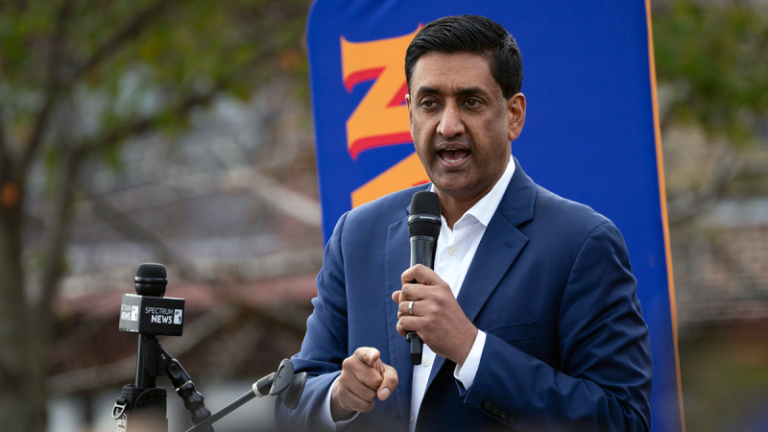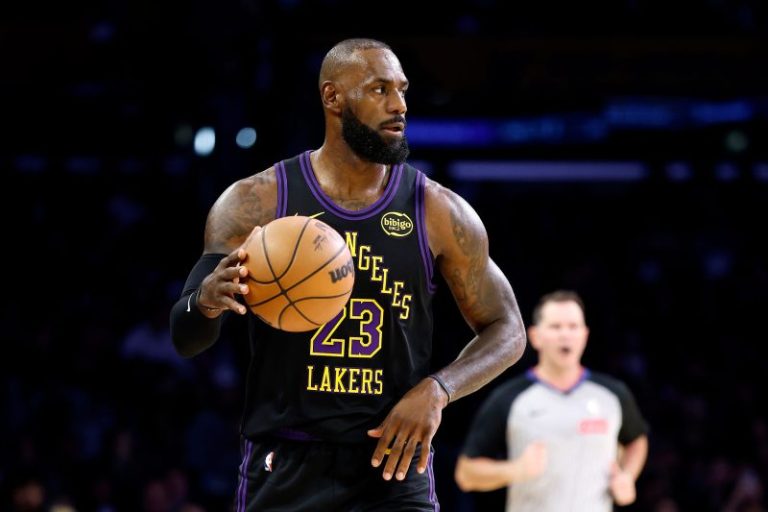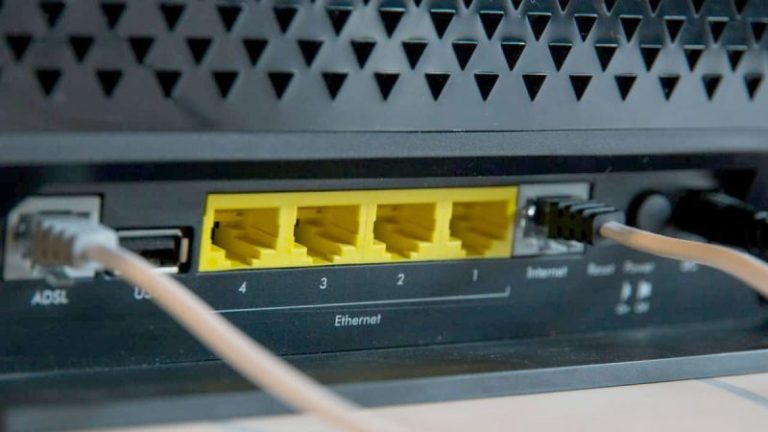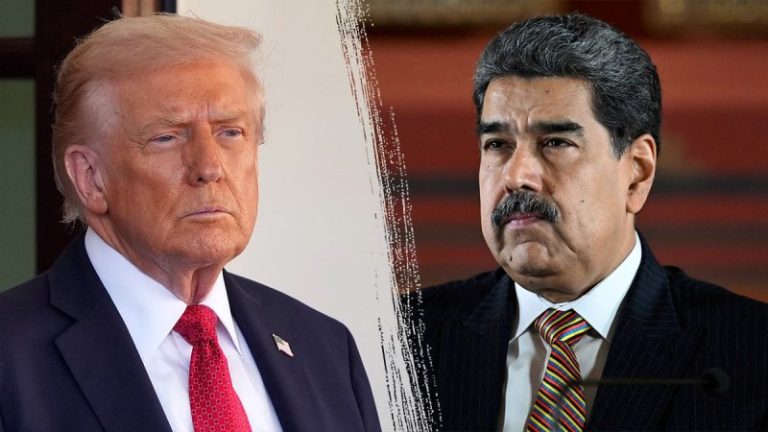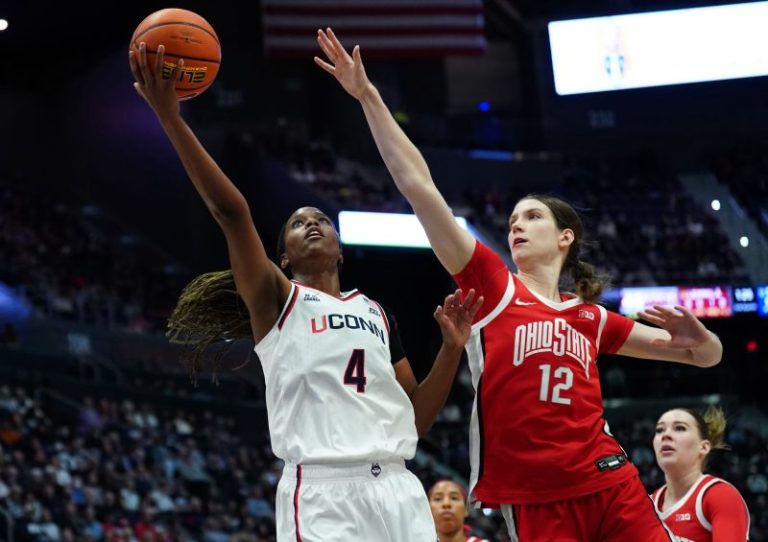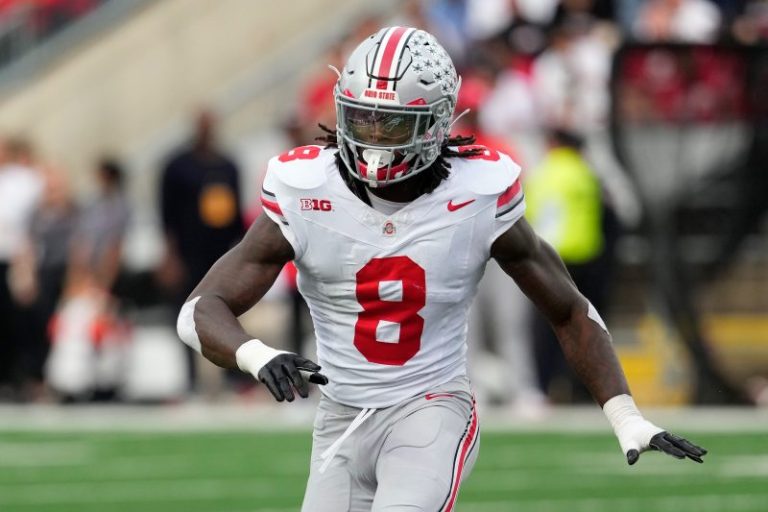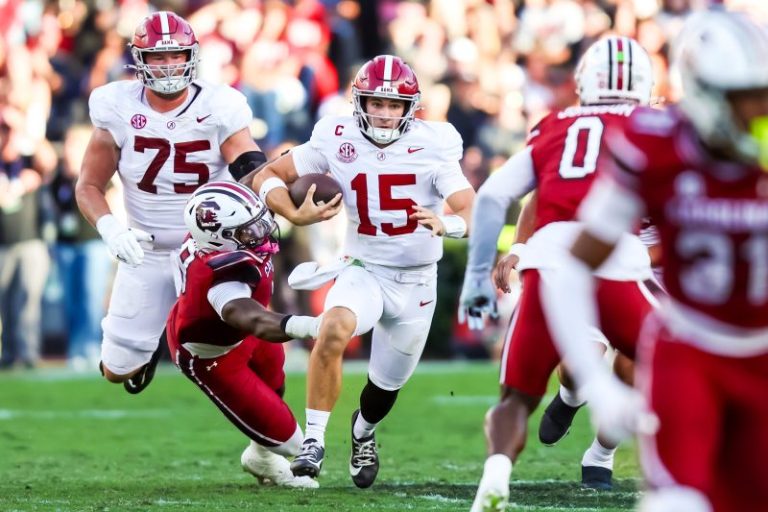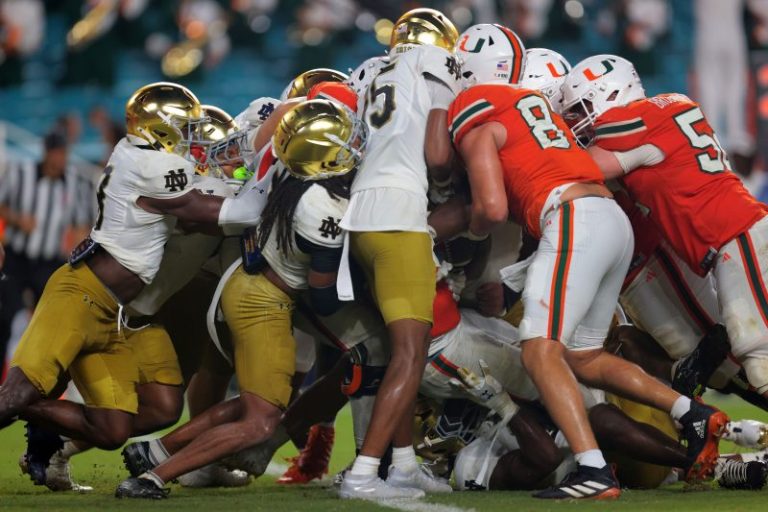Week 11 didn’t disrupt the NFL hierarchy. Many of the favored teams or those with better records than their opponents finished the week with another victory.
A narrow defeat, thanks to a last-minute field goal, kept the Tennessee Titans from fighting for win No. 2 on the season. Tennessee remains the lone one-win team left in the NFL and on track to hold the No. 1 overall pick for the second year in a row.
The Titans took quarterback Cam Ward No. 1 overall this past April, the team’s first No. 1 overall pick since the days of the Houston Oilers back in 1978. After a decades-long break, they may have the top pick in back-to-back years, becoming the first franchise to do so since Jacksonville in 2021 and 2022.
So what should the Titans do? They have a potential quarterback of the future in Ward and this isn’t a strong enough quarterback class that makes a team trading up immediately obvious. They could have their choice of non-quarterback positions in a draft rife with defensive talent.
Edge rusher is the common choice given the positional value. You have to go back to the 2013 NFL Draft to find the last non-quarterback and non-edge rusher to be taken No. 1 overall. That likely won’t change in 2026.
We’ve compiled what experts at CBS Sports, Athlon Sports and The Draft Network think will happen in the first round of the 2026 NFL Draft. Here’s how they compare:
2026 NFL mock draft roundup
1. Tennessee Titans
CBS Sports: Edge Rueben Bain Jr., Miami (FL)
Athlon Sports: Edge Rueben Bain Jr., Miami (FL)
The Draft Network: LB Arvell Reese, Ohio State
CBS Sports: ‘Realistically, the Titans will try their best to move out of the No. 1 spot for a haul of picks. From a player fit perspective, though, Bain feels like the perfect defensive end to pair with Jeffery Simmons on the interior. He’s an enforcer who resets the line in the run game and pushes pockets consistently as a pass rusher.’
2. New York Giants
CBS Sports: DT Peter Woods, Clemson
Athlon Sports: LB Arvell Reese, Ohio State
The Draft Network: WR Jordyn Tyson, Arizona State
The Draft Network: ‘For the New York Giants, this offseason should be all about surrounding Jaxson Dart with the support he needs to mature properly as a quarterback in the NFL… The smart thing to do in this spot is draft another receiver, and when Nabers is completely healthy, Dart now has two explosive, dynamic, versatile weapons to throw the football to.’
3. Cleveland Browns
CBS Sports: QB Ty Simpson, Alabama
Athlon Sports: QB Fernando Mendoza, Indiana
The Draft Network: QB Fernando Mendoza, Indiana
Athlon Sports: ‘There’s still time for Dillon Gabriel (or Shedeur Sanders) to prove they’re capable of being a franchise quarterback, but the early returns haven’t been encouraging. If things don’t change in a big way down the stretch, the Browns shouldn’t be afraid to move on from those mid-round picks and take another swing on a rookie with a higher ceiling.’
4. New Orleans Saints:
CBS Sports: WR Jordyn Tyson, Arizona
Athlon Sports: S Caleb Downs, Ohio State
The Draft Network: Edge Rueben Bain Jr., Miami (FL)
CBS Sports: ‘For the Saints, it’s only going to get worse before it gets better. Because of that, they may choose to pass on this year’s quarterback class to give Tyler Shough a little longer leash at the helm. Giving him a No. 1 receiver like Tyson would transform New Orleans’ passing attack with a true every-level route winner.’
5. New York Jets:
CBS Sports: QB Fernando Mendoza, Indiana
Athlon Sports: QB Ty Simpson, Alabama
The Draft Network: QB Ty Simpson, Alabama
The Draft Network: ‘The New York Jets were sellers at the trade deadline, which shows that they are on the brink of dismantling the entire structure—from the front office to the coaches to the quarterback position—and starting in a brand-new direction. And when most franchises are starting over, they begin with the most important position on the field.’
6. Las Vegas Raiders:
CBS Sports: LB Arvell Reese, Ohio State
Athlon Sports: QB Dante Moore, Oregon
The Draft Network: QB Dante Moore, Oregon
Athlon Sports: ‘Geno Smith has looked like a shell of the version we saw in Seattle the past couple of years, leaving the Raiders with a massive question mark at quarterback in the short-term, as well as the future. If they want a poised, precise passer who can win from the pocket and still bring enough athleticism to make plays outside of structure, Moore has proven this season that he can consistently do both.’
7. Washington Commanders:
CBS Sports: WR Carnell Tate, Ohio State
Athlon Sports: WR Jordyn Tyson, Arizona State
The Draft Network: WR Carnell Tate, Ohio State
The Draft Network: ‘If the Commanders want to maximize Jayden Daniels and give themselves the best chance to actually win championships, they need to invest. So with this pick, the Commanders turn to Ohio State—a familiar school for the team since they drafted Terry McLaurin from there—and take Carnell Tate. This should be the start of surrounding Daniels with a formidable set of weapons..’
8. Los Angeles Rams (via Atlanta Falcons):
CBS Sports: S Caleb Downs, Ohio State
Athlon Sports: QB LaNorris Sellers, South Carolina
The Draft Network: Edge Cashius Howell, Texas A&M
CBS Sports: ‘The Rams are a nickel-base team through and through. They want as many defensive backs on the field as possible on every play, and Downs is the kind of defender who can keep them strong against the run, even out of those looks.’
9. Cincinnati Bengals:
CBS Sports: RB Jeremiyah Love, Notre Dame
Athlon Sports: DT Peter Woods, Clemson
The Draft Network: OT Spencer Fano, Utah
The Draft Network: ‘The Cincinnati Bengals’ offseason goals should be to protect Joe Burrow at all costs. That starts with the draft and selecting an OT in the first round. Spencer Fano is a plug-and-play starter and should help boost this Bengals offensive line.’
10. Arizona Cardinals:
CBS Sports: WR Chris Brazzell II, Tennessee
Athlon Sports: OT Spencer Fano, Utah
The Draft Network: OL Francis Mauigoa, Miami (FL)
CBS Sports: ‘Brazzell is a throwback deep threat at 6-foot-5 with exceptional wheels. The Cardinals have really been missing a vertical element to their passing attack this season, so Brazzell’s 12 deep catches would be a welcome addition.’
11. Miami Dolphins:
CBS Sports: OT Spencer Fano, Utah
Athlon Sports: WR Carnell Tate, Ohio State
The Draft Network: DT Peter Woods, Clemson
The Draft Network: ‘The Miami Dolphins moved on from GM Chris Grier, and it appears that this roster is headed in a different direction. One thing this roster has consistently needed over the past few years is a complete overhaul of the trenches on both offense and defense. To begin that process, the Dolphins draft IDL Peter Woods and pair him with Kenneth Grant. This combination of Woods and Grant should solidify the Dolphins in the trenches moving forward.’
12. Dallas Cowboys:
CBS Sports: Edge David Bailey, Texas Tech
Athlon Sports: Edge Keldric Faulk, Auburn
The Draft Network: RB Jeremiyah Love, Notre Dame
Athlon Sports: ‘Replacing Micah Parsons is no easy task, and while the Cowboys are unlikely to find that caliber of player at this spot, that shouldn’t keep them from trying. Faulk would be an ideal candidate, thanks to his rare blend of size, athleticism and versatility that allows him to line up all across the defensive front and wreak having on opposing offenses in a wide variety of ways.’
13. Minnesota Vikings:
CBS Sports: CB Jermod McCoy, Tennessee
Athlon Sports: CB Mansoor Delane, LSU
The Draft Network: S Caleb Downs, Ohio State
CBS Sports: ‘McCoy has still yet to play a snap of football this year after a January ACL tear, but his sophomore tape was still good enough to keep him as CB1. He can be the island-man corner the Vikings defense has been missing this season.’
14. Baltimore Ravens:
CBS Sports: Edge Keldric Faulk, Auburn
Athlon Sports: Edge David Bailey, Texas Tech
The Draft Network: LB Sonny Styles, Ohio State
Athlon Sports: ‘Baltimore’s defense has been a massive disappointment for much of the season so far, and they need to find as many instant-impact players as they can in the offseason. That needs to start up front, where they lack a true game-changing pass rusher off the edge. That’s exactly what Bailey has been for the Red Raiders this year, with the explosiveness and bend to beat opposing tackles off the ball and around the arc to the quarterback on a regular basis.’
15. Kansas City Chiefs
CBS Sports: OL Francis Mauigoa, Miami (FL)
Athlon Sports: TE Kenyon Sadiq, Oregon
The Draft Network: TE Kenyon Sadiq, Oregon
The Draft Network: ‘If Kenyon Sadiq falls this far in the draft, I think the Kansas City Chiefs make this selection without hesitation. Travis Kelce appears to be at the very end of his career, and Patrick Mahomes needs another tight end he can rely on to work the middle of the field and make big plays when needed. Sadiq has the athletic profile and talent to do just that, giving the Chiefs a top-tier tight end for the next decade.’
16. Houston Texans
CBS Sports: OL Olaivavega Ioane, Penn State
Athlon Sports: OL Francis Mauigoa, Miami (FL)
The Draft Network: OT Kadyn Proctor, Alabama
CBS Sports: ‘Ioane isn’t the left tackle the Texans need, but he’s a high-end pass protector nonetheless, and beggars can’t be choosers. He’d be a Day 1 starter at left guard.’
17. Carolina Panthers
CBS Sports: CB Avieon Terrell, Clemson
Athlon Sports: OT Kadyn Proctor, Alabama
The Draft Network: CB Mansoor Delane, LSU
The Draft Network: ‘The Carolina Panthers have spent resources on their offense over the past few drafts to improve their receiver corps and those investments appear to be paying off, as Bryce Young and the Panthers’ offense have looked the best since they drafted him. So in this draft, they turn their attention to the defensive side of the football and select LSU CB Mansoor Delane.’
18. Detroit Lions
CBS Sports: OL Emmanuel Pregnon, Oregon
Athlon Sports: Edge T.J. Parker, Clemson
The Draft Network: Edge Matayo Uiagalelei, Oregon
CBS Sports: ‘The Lions want to keep their offensive line a dominant unit, and this is how you do it. Pregnon is having a standout year after transferring from USC. He’s only allowed two pressures all season.’
19. Tampa Bay Buccaneers
CBS Sports: LB C.J. Allen, Georgia
Athlon Sports: LB Sonny Styles, Ohio State
The Draft Network: LB C.J. Allen, Georgia
The Draft Network: ‘The Buccaneers are getting older at certain positions, such as linebacker, and need to inject youth into these groups. CJ Allen is a fast and physical linebacker who should learn a lot from Pro Bowler Lavonte David and give the Buccaneers a highly talented linebacker for the next decade.’
20. Cleveland Browns (via Jacksonville Jaguars)
CBS Sports: OT Caleb Lomu, Utah
Athlon Sports: OT Caleb Lomu, Utah
The Draft Network: OT Caleb Lomu, Utah
Athlon Sports: ‘After landing their new franchise passer at the top of the draft, the Browns could go in any number of directions with their extra first-rounder from their draft-day trade back in April. Rebuilding efforts should always start in the trenches, and that’s where Cleveland could invest in a long-term upgrade at tackle with Lomu, who has been a dominant force all year long. Immediately improving Mendoza’s protection would be a great way to start this draft off strong.’
21. Pittsburgh Steelers
CBS Sports: CB Mansoor Delane, LSU
Athlon Sports: WR Makai Lemon, USC
The Draft Network: QB Darian Mesah, Duke
The Draft Network: ‘Because the Pittsburgh Steelers signed up for the one-year agreement with Aaron Rodgers, they will enter the offseason with a vacancy at the quarterback position. This puts them in a position to have to draft a quarterback. In this spot, the Steelers decide to draft Duke signal-caller Darian Mensah, a highly skilled thrower of the football who could be the future for Pittsburgh at the position.’
22. Los Angeles Chargers
CBS Sports: DL Kayden McDonald, Ohio State
Athlon Sports: Edge Cashius Howell, Texas A&M
The Draft Network: CB Jermod McCoy, Tennessee
CBS Sports: ‘The Chargers’ rotation of defensive tackles has been lacking the depth Jim Harbaugh usually prefers. That changes with the addition of McDonald. He’s the single best run-defending defensive lineman in the country.’
23. San Francisco 49ers
CBS Sports: Edge T.J. Parker, Clemson
Athlon Sports: CB Jermod McCoy, Tennessee
The Draft Network: CB Avieon Terrell, Clemson
The Draft Network: ‘The San Francisco 49ers have been decimated by injuries, but their culture has shown through with the next-man-up mentality offensively. Defensively, they’ve played well, but there are still spots on this roster that need upgrades, and one of those spots is the corner position. Avieon Terrell is a versatile defensive back who can play on the outside and in the nickel at a high level, and he should be a welcome addition to the 49ers.’
24. Dallas Cowboys (via Green Bay Packers)
CBS Sports: LB Sonny Styles, Ohio State
Athlon Sports: DL A’Mauri Washington, Oregon
The Draft Network: WR Malachi Fields, Notre Dame
CBS Sports: ‘Styles is another infusion of athleticism into the Cowboys’ front seven. He’s the best sideline-to-sideline linebacker in college football. His ability to cover ground at the second level would be a massive value-add in coverage for the Cowboys.’
25. Chicago Bears
CBS Sports: OT Kadyn Proctor, Alabama
Athlon Sports: RB Jeremiyah Love, Notre Dame
The Draft Network: Edge LT Overton, Alabama
Athlon Sports: ‘There are more glaring needs on defense, but if the board falls this way, Love is easily the best player available. D’Andre Swift has been solid when healthy, and rookie Kyle Monangai has flashed some potential, but Ben Johnson knows as well as anyone what you can do with multiple impact players in the backfield. Love is a three-down weapon who can make big plays happen on the ground and through the air, and he’s make an instant splash in one of the league’s most exciting offenses.’
26. Buffalo Bills
CBS Sports: WR KC Concepcion, Texas A&M
Athlon Sports: WR Denzel Boston, Washington
The Draft Network: WR Chris Bell, Louisville
CBS Sports: ‘Concepcion is the separator the Bills offense has been missing. He’d add a vertical element as well as the ability to be their go-to guy on third downs. He’s caught 47 passes for 787 yards and eight scores this year.’
27. Seattle Seahawks
CBS Sports: DL Christen Miller, Georgia
Athlon Sports: LB C.J. Allen, Georgia
The Draft Network: OL Olaivavega Ioane, Penn State
Athlon Sports: ‘Seattle’s defense has been dominant so far this season, but head coach Mike McDonald won’t rest on his laurels and avoid opportunities to make his unit even stronger next year and beyond. That could start with a first-round investment at linebacker, where Allen would bring a strong blend of athleticism, physicality, and football IQ that has made him an every-down force for the Bulldogs.’
28. New York Jets (via Indianapolis Colts)
CBS Sports: WR Makai Lemon, USC
Athlon Sports: CB Avieon Terrell, Clemson
The Draft Network: Edge Zion Young, Missouri
The Draft Network: The New York Jets offloaded Pro Bowl IDL Quinnen Williams right before the trade deadline, which leaves a hole upfront in the trenches. Zion Young is primarily an edge rusher, but he can also kick inside and rush the passer from the interior. Young should be a welcome addition, giving the Jets some youth and talent along the trenches as they begin to reset their roster and chart a new direction.’
29. Los Angeles Rams
CBS Sports: LB Jake Golday, Cincinnati
Athlon Sports: CB Colton Hood, Tennessee
The Draft Network: OT Isaiah World, Oregon
CBS Sports: ‘Golday is a former edge rusher who’s turned into one of the most complete linebackers in college football. He still has that edge size but moves like an undersized linebacker in space.’
30. New England Patriots
CBS Sports: OT Caleb Tiernan, Northwestern
Athlon Sports: Edge LT Overton, Alabama
The Draft Network: Edge Keldric Faulk, Auburn
Athlon Sports: ‘As Mike Vrabel rebuilds the Pats’ defense, he’ll continue to put a premium on physicality, toughness, and versatility. That could lead New England to Overton, who checks all of those boxes and then some. He can line up just about anywhere along the defensive front, with a blend of power and athleticism that can beat opposing blockers in multiple ways. Throw in his nonstop motor and leadership ability, and he’s the perfect fit.’
31. Philadelphia Eagles
CBS Sports: TE Kenyon Sadiq, Oregon
Athlon Sports: Edge Matayo Uiagalelei, Oregon
The Draft Network: WR Chris Brazzell II, Tennessee
Athlon Sports: ‘Even after acquiring Jaelen Phillips via trade from the Dolphins, Howie Roseman should keep taking swings at finding high-impact edge rushers. Uiagalelei has a complete skill set, with the size, length, athleticism and strength to make a huge impact on every down. Adding him to an already dangerous rotation of front-line defenders would ensure Philly keeps their defense one of the league’s most dominant units across the board.’
32. Denver Broncos
CBS Sports: WR Denzel Boston, Washington
Athlon Sports: LB Anthony Hill Jr., Texas
The Draft Network: WR Ja’Kobi Lane, USC
The Draft Network: ‘The Denver Broncos’ offense has sputtered this season and lacked consistency in Bo Nix’s second year, which is a reflection of the need to add more talent to the receiver room. So with this pick, I believe the Broncos draft USC WR Ja’Kobi Lane. Lane is a big-bodied receiver who thrives in contested catch situations and gives Nix another reliable target to throw the football to.’
This post appeared first on USA TODAY


